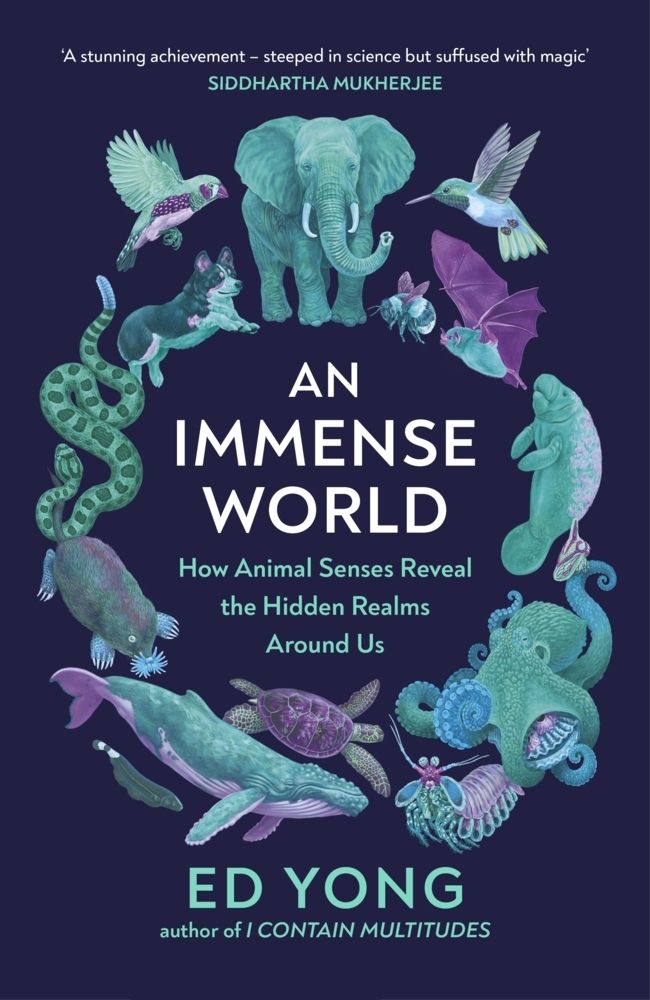hugh reviewed An Immense World by Ed Yong
Amazing
5 stars
A very dense read because it’s so packed with startling facts, but definitely worth the investment in time. This is really an extraordinary book.

Paperback, 464 pages
English language
Published June 29, 2022 by The Bodley Head Ltd.
The Earth teems with sights and textures, sounds and vibrations, smells and tastes, electric and magnetic fields. But every animal is enclosed within its own unique sensory bubble, perceiving only a tiny sliver of an immense world. This book welcomes us into previously unfathomable dimensions - the world as it is truly perceived by other animals.
We encounter beetles that are drawn to fires, turtles that can track the Earth's magnetic fields, fish that fill rivers with electrical messages, and humans that wield sonar like bats. We discover that a crocodile's scaly face is as sensitive as a lover's fingertips, that plants thrum with the inaudible songs of courting bugs, and that even simple scallops have complex vision.
We learn what bees see in flowers, what songbirds hear in their tunes, and what dogs smell on the street. We listen to stories of pivotal discoveries in the field, while looking …
The Earth teems with sights and textures, sounds and vibrations, smells and tastes, electric and magnetic fields. But every animal is enclosed within its own unique sensory bubble, perceiving only a tiny sliver of an immense world. This book welcomes us into previously unfathomable dimensions - the world as it is truly perceived by other animals.
We encounter beetles that are drawn to fires, turtles that can track the Earth's magnetic fields, fish that fill rivers with electrical messages, and humans that wield sonar like bats. We discover that a crocodile's scaly face is as sensitive as a lover's fingertips, that plants thrum with the inaudible songs of courting bugs, and that even simple scallops have complex vision.
We learn what bees see in flowers, what songbirds hear in their tunes, and what dogs smell on the street. We listen to stories of pivotal discoveries in the field, while looking ahead at the many mysteries which lie unsolved.
Ed Yong coaxes us beyond the confines of our own senses, allowing us to perceive the threads of scent, waves of electromagnetism and pulses of pressure that surround us. Because in order to understand our world we don't need to travel to other places; we need to see through other eyes.
A very dense read because it’s so packed with startling facts, but definitely worth the investment in time. This is really an extraordinary book.
A really stunning exploration of sensing. And a really nice incorporation of von Uexküll's "umwelt." Particularly compelling is the emphasis upon the entanglement of communication and sensory capacity.
An impressive book, full of wonderful facts and some grounded speculations looking at how various creatures sense, and make sense, of the world around them. Ed Yong (the author) reminds us that trying to understand the behaviour of creatures based on what we can sense can be futile. And by forcing creatures into a human centric world (near constant lighting at night, urban noise, artificial chemicals in the environment), we may be altering their behaviour and damaging the natural biodiversity.
Ed Yong starts by introducing the reader to the term, Umwelt (as used by biologist Jakob von Uexkül) to represent each creature's unique perception of the world. He then shows us the Umwelts of various creatures as experienced through the various senses: smell, taste, light, colour, the sensation of pain and heat, contact, vibrations and sound. He then covers three of the more mysterious senses; echolocation and the ability to …
An impressive book, full of wonderful facts and some grounded speculations looking at how various creatures sense, and make sense, of the world around them. Ed Yong (the author) reminds us that trying to understand the behaviour of creatures based on what we can sense can be futile. And by forcing creatures into a human centric world (near constant lighting at night, urban noise, artificial chemicals in the environment), we may be altering their behaviour and damaging the natural biodiversity.
Ed Yong starts by introducing the reader to the term, Umwelt (as used by biologist Jakob von Uexkül) to represent each creature's unique perception of the world. He then shows us the Umwelts of various creatures as experienced through the various senses: smell, taste, light, colour, the sensation of pain and heat, contact, vibrations and sound. He then covers three of the more mysterious senses; echolocation and the ability to sense electric and magnetic fields. Each sense is shown by giving examples of various creatures whose ability to use the sense differs and/or exceeds our abilities to use them.
He then closes the book by showing how animals draw upon the various senses to form each creature's Umwelt, and how we are altering what creatures are sensing from their surroundings by 'polluting' the environment with our lights, noise and artificial chemicals.
Throughout the book, Ed Yong features the research and work being done by numerous researchers to understand how creatures sense the world and, possibly, how they make sense of the world using the information provided by the senses.
It may be impossible to fully imagine how even familiar creatures like dogs sense the world compared to us, much less creatures like spiders, birds, fishes, electric eels, moles or elephants (all examples from the book). But Ed Yong gives it a good try, and by the end, you'll probably appreciate the fact that we may never share the Umwelt of other creatures, but you'll be aware that they see the world differently from us and that needs to be accounted for when trying to understand why they behave in certain ways that may seem puzzling to us, limited as we are by our own Umwelts.